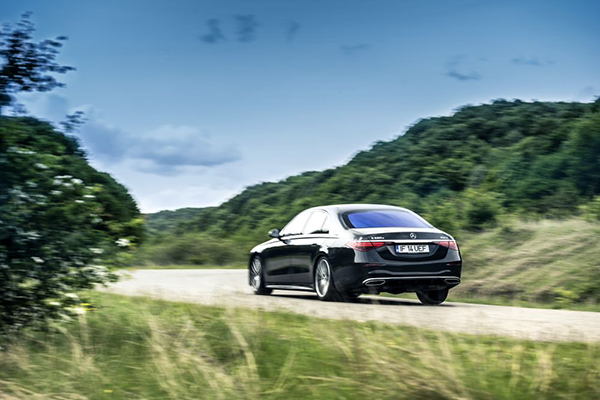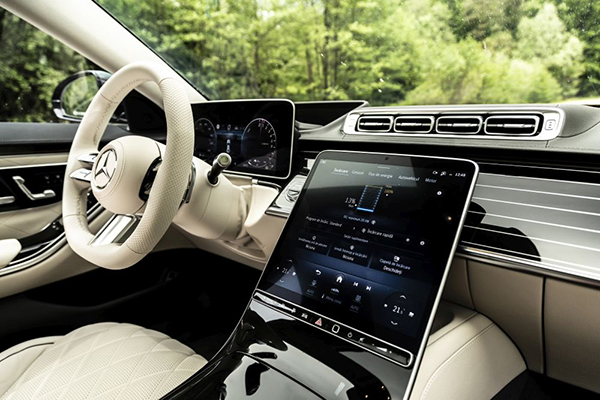Mercedes-Benz is betting more on the PHEV card in the new generation S-Class, offering no less than four versions and, for the first time, all-wheel drive combined with the PHEV drive system. In the test, the extended wheelbase version of Mercedes S 580 e 4Matic.

For High-end models, all-wheel drive and Plug-in hybrid are the ideal combinations in this transition to the electric era, as they provide emission-free mobility and decent electric range in crowded cities, long driving ranges with the Plug-In drive for long trips, and the proper dynamics thanks to the electric motor. That’s why this type of powertrain is a perfect fit for the S-Class, and Mercedes offers no less than four versions, actually seven if you count both short and long body styles: S 450 e, S 580 e/S 580 e 4Matic (all three with short and long wheelbase) and the flagship AMG S 63 E Performance (P3 hybrid system with electrified rear axle).
We tested the Mercedes S 580 e 4Matic PHEV, available for the first time as an all-wheel drive. The S 580 e 4Matic replaces the former S 560 e, but the differences are significant. In addition to all-wheel drive, which has not been available before, the new model comes with a much larger battery with more than double the capacity (28.6 kWh compared to 13.5 kWh gross) that promises a more than double WLTP electric range of 94 to 113 km (58-70 miles) compared to 50 km (31 miles) before.
Mercedes has also done much work on the rear suspension, which is more compact, and its arms are 27 mm (1.06 in) lower. So while we now have all-wheel drive, the much larger battery could be mounted more down, and the boot floor no longer has that threshold that made it difficult to load the boot optimally. The 350-liter (21,358 cu in) boot volume is no bigger than the old generation, but the boot’s shape is regular and more practical.
A 3-liter inline 6-cylinder engine works under the bonnet instead of the old V6 with the same displacement, developing the same power and torque of 367 ps (362 hp) and 500 Nm (369 lb-ft), respectively. On the other hand, the electric motor is more powerful, with 150 ps (148 hp) compared to 122 ps (120 hp) before.

Very efficient in the Hybrid Mode
We hit the road with the battery 85% charged and selected Electric mode. We drove around town for 65 km until the battery was fully discharged. Considering the 85% charge percentage at the start, this gives an electric range of about 76 km (47 miles), with a consumption of 33 kWh/100 km. That’s more than double the old figure of around 33 km (20,5 miles) but below the promised minimum of 94 km (58 miles). There is no Charge mode, but the battery can be charged on the go using Sport mode. The test car also had the 600 euro ($645) option of the DC charging socket, Mercedes being the only one to offer DC charging on PHEV models. So in 20 minutes, the battery charges from 0 to 80%.
With the battery discharged, the energy consumption was more than decent at 12.6 l/100 km (18.6 mpg). Once the battery was charged, I switched to Hybrid mode and had low consumption relative to the power level: 9.6 l/100 km (24.5 mpg) and 8.8 kWh/100 km. The conclusion is only one: the promised electric range is a bit too optimistic, but in Hybrid mode, the car consumes very little and is highly efficient. A B mode (Battery Hold) allows the battery energy to be conserved for later use. In Hybrid mode, the heat engine harmonizes very well with the electric motor placed in the 9-speed automatic gearbox. The switch from one mode to another is seamless, with refinement at its finest.

Also gone is the pressure point on the accelerator pedal that signals you not to press above a certain level if you don’t want to start the conventional engine. Now, in Electric mode, if you don’t suddenly use the kick-down, you’ll drive pure electric in any situation and can reach 140 kph (87 mph). Getting through heavy traffic without emissions and noise is refreshing and eco-friendly. The combustion engine doesn’t make much noise when running, thanks to the exceptional soundproofing with sound-insulated laminated glass and foam insulation tires. At high acceleration, only a pleasant low background noise is heard.
With adaptive air suspension as standard, the S 580 e 4Matic runs like on a cushion of air, and compared to the previously tested S 580 4Matic with 21-inch wheels, the PHEV version is softer tuned and even in Sport mode prioritizes comfort. The 4.5-degree-angle all-wheel steering fitted to the test car helps to handle tight spaces and corners, but in sporty driving, you feel the slight inertia of the rear axle because of the 241 kg (531 lbs) battery placed above the rear axle.
At 140,420 euro ($151,205), the S 580 e 4Matic costs a small fortune, being at almost the same level like the EQS 580 4Matic (141,705 euro/$152,387), which has a lower finish quality. Without a single square inch of plastic, and not just because we were impressed by the optional Manufaktur trim, the S-Class has a timeless elegance, a feeling not yet touched by the EQS.
Verdict
The new Mercedes S 580 e 4Matic combines the Plug-In Hybrid system with all-wheel drive for the first time and has a more practical trunk. The high-capacity battery has more than double the electric range compared with the former generation, but not quite as much as Mercedes promises. Instead, it impresses with the hybrid system’s efficiency with low consumption. Moreover, it is at the same price with the EQS 580 4Matic and has a better-quality interior.
2024 Mercedes-Benz S 580 e 4MATIC Ideal Combination
07/06/2023
No Comments
Mercedes-Benz | Mercedes-AMG
Click to rate this post
[Total: 1 Average: 5]